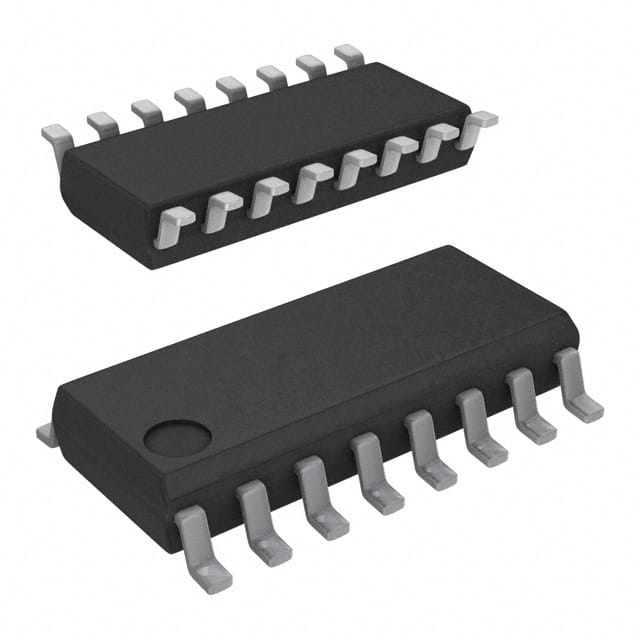Подробную информацию о продукте см. в характеристиках.

CD74AC174M
Product Overview
- Category: Integrated Circuit (IC)
- Use: Flip-Flop
- Characteristics: High-speed, low-power consumption
- Package: SOIC (Small Outline Integrated Circuit)
- Essence: Sequential logic element
- Packaging/Quantity: Tape and reel, 2500 pieces per reel
Specifications
- Supply Voltage Range: 2V to 6V
- Logic Family: AC
- Number of Flip-Flops: 6
- Clock Trigger Type: Positive Edge
- Output Type: Complementary
- Operating Temperature Range: -40°C to +85°C
Detailed Pin Configuration
The CD74AC174M has a total of 16 pins. The pin configuration is as follows:
- CLR (Clear)
- D (Data Input)
- CP (Clock Pulse)
- Q0 (Output 0)
- Q1 (Output 1)
- Q2 (Output 2)
- Q3 (Output 3)
- Q4 (Output 4)
- Q5 (Output 5)
- GND (Ground)
- Qn (Complementary Outputs)
- VCC (Supply Voltage)
- Qn (Complementary Outputs)
- Q5 (Output 5)
- Q4 (Output 4)
- Q3 (Output 3)
Functional Features
- High-speed operation: The CD74AC174M operates at high clock frequencies, making it suitable for applications that require fast data processing.
- Low-power consumption: This IC is designed to minimize power consumption, making it energy-efficient and suitable for battery-powered devices.
- Clear function: The CLR pin allows the user to reset the flip-flop to its initial state, providing flexibility in controlling the circuit's behavior.
- Complementary outputs: The CD74AC174M provides both normal and complementary outputs, allowing for versatile signal routing and compatibility with various systems.
Advantages and Disadvantages
Advantages: - High-speed operation enables efficient data processing. - Low-power consumption prolongs battery life in portable devices. - Clear function provides flexibility in circuit control. - Complementary outputs offer versatility in signal routing.
Disadvantages: - Limited number of flip-flops (6) may restrict the complexity of sequential logic circuits. - Operating temperature range (-40°C to +85°C) may not be suitable for extreme environments.
Working Principles
The CD74AC174M is a positive-edge-triggered D-type flip-flop. It stores and transfers data based on the rising edge of the clock pulse. When the clock pulse transitions from low to high, the input data (D) is captured and stored in the flip-flop. The stored data is then available at the output pins (Q0-Q5). The CLR pin can be used to reset the flip-flop to its initial state, clearing all stored data.
Detailed Application Field Plans
The CD74AC174M is widely used in various digital systems and applications, including:
- Data storage and transfer: The flip-flop's ability to store and transfer data makes it suitable for applications such as registers, counters, and shift registers.
- Synchronous logic circuits: The positive-edge-triggered nature of the flip-flop allows for synchronous operation, making it useful in systems that require precise timing and synchronization.
- Control systems: The CD74AC174M can be utilized in control systems to store and manipulate control signals, enabling efficient control of various processes.
- Communication systems: Flip-flops are essential components in communication systems, where they are used for data synchronization, error detection, and signal routing.
Detailed and Complete Alternative Models
- SN74AC174: Similar to CD74AC174M, but available in a different package (DIP - Dual Inline Package).
- MC74AC174: Another alternative with similar specifications and functionality, offered by a different manufacturer (Motorola).
These alternative models can be used as substitutes for the CD74AC174M, depending on specific requirements and availability.
Word count: 511 words
Перечислите 10 распространенных вопросов и ответов, связанных с применением CD74AC174M в технических решениях.
Sure! Here are 10 common questions and answers related to the application of CD74AC174M in technical solutions:
Q: What is CD74AC174M? A: CD74AC174M is a hex D-type flip-flop integrated circuit (IC) that can store and manipulate digital signals.
Q: What is the voltage supply range for CD74AC174M? A: The voltage supply range for CD74AC174M is typically between 2V and 6V.
Q: How many flip-flops are there in CD74AC174M? A: CD74AC174M consists of six individual flip-flops, making it a hex D-type flip-flop IC.
Q: What is the maximum clock frequency supported by CD74AC174M? A: CD74AC174M can support clock frequencies up to 100 MHz, making it suitable for high-speed applications.
Q: Can CD74AC174M be used for edge-triggered or level-triggered operations? A: CD74AC174M is designed for edge-triggered operations, specifically positive-edge triggering.
Q: What is the output drive capability of CD74AC174M? A: CD74AC174M has a typical output drive capability of 24 mA, allowing it to drive standard TTL loads.
Q: Is CD74AC174M compatible with CMOS logic levels? A: Yes, CD74AC174M is compatible with both CMOS and TTL logic levels, making it versatile for various applications.
Q: Can CD74AC174M be cascaded to create larger counters or shift registers? A: Yes, CD74AC174M can be cascaded to create larger counters or shift registers by connecting the outputs of one IC to the inputs of another.
Q: What is the power consumption of CD74AC174M? A: The power consumption of CD74AC174M is relatively low, typically around 10 mW.
Q: What are some common applications of CD74AC174M? A: CD74AC174M is commonly used in applications such as data storage, counters, shift registers, frequency dividers, and digital signal processing circuits.
Please note that these answers are general and may vary depending on specific datasheet specifications and application requirements.

